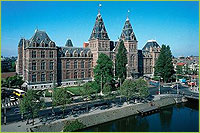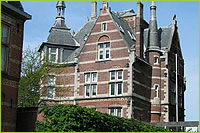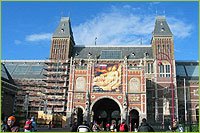| |
 |
|
Rijksmuseum
When the Rijksmuseum was opened to the public for the first time in 1800 as the
Nationale Konstgallerij (National Art Gallery), it was housed in the Huis ten Bosch in
The Hague. In 1808 it moved to Amsterdam, where it was to be seen first in the Palace
on Dam Square and later in
the Trippenhuis on Kloveniersburgwal. As the collection grew,
it soon outgrew its palatial quarters and the museum was forced
to find new premises.
To solve the problem of
where to house the collection it was
eventually decided in 1876
to build the present Rijksmuseum. Architect P.J.H. Cuypers designed a historical building
using a mixture of Gothic and Renaissance styles. It was officially opened in 1885. By
now the collection had been augmented by the collection of Amsterdam municipality,
which included the estate of A. de Hoop, with paintings such as the Jewish Bride by Rembrandt. The new building also provided space for the Museum of History and Art
from The Hague. The collection of 19th-century art at Paviljoen Welgelegen in
Haarlem
was also moved into the new building.
Over time many alterations to the original design
have been made. One renovation
followed another in quick succession. In 1906-1909
and 1913-1916 a new wing was
added
for the collection of 19th-century art. After the
Second World War the collection of the Friends of Asian
Art was also kept in the extension.
In the 1950s and 1960s the two courtyards were
filled with exhibition rooms. During the coming renovation the plan is to remove these
blocks, so that the courtyards will again
have light and space. The aims of this major renovation are to do justice to Cuypers's
original structue, to make daylight an important factor once more and to create good
logistical conditions. The new Rijksmuseum will
then be ready for the 21st-century visitor.
From December 2003 to 2008 the Rijksmuseum Amsterdam will undergo the biggest rebuilding, renovation and modernisation programme in its history. During this period the finest works from the 17th century in the Rijksmuseum will continue to be on view under
the title The Masterpieces. The redesigned Philips Wing will provide an opportunity to see
the highlights of the Golden Age together in surprising combinations. The more than 400 masterpieces will be on display in the Philips Wing from 20 December. |





